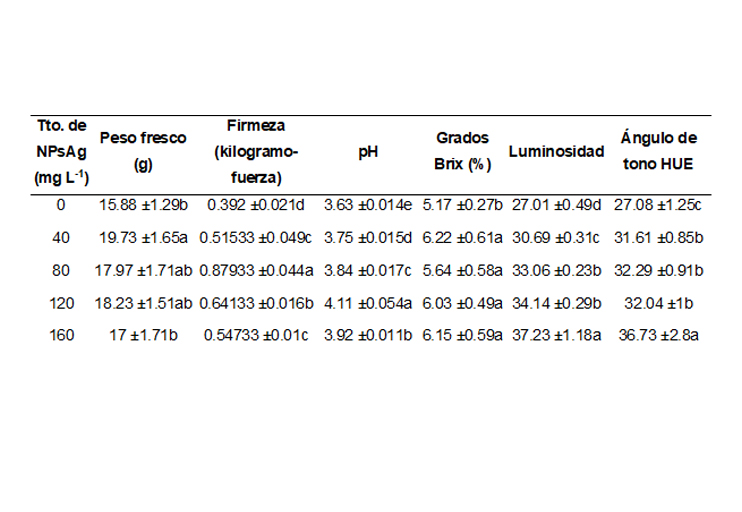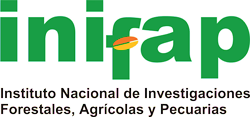Silver nanoparticles in strawberry quality
DOI:
https://doi.org/10.29312/remexca.v16i6.3808Keywords:
Fragaria x ananassa Duch., conservation, indicators, nanotechnologyAbstract
Silver nanoparticles, being inorganic biostimulants in strawberry crops, can serve as food preservative compounds. The present research was conducted with the aim of evaluating the effect of applying silver nanoparticles via leaves and roots at increasing doses on the quality of strawberry (Fragaria x ananassa Duch.) cultivar Festival. The experiment was established in a greenhouse in the experimental agricultural field of the Chapingo Autonomous University, Texcoco, State of Mexico, in 2022 and 2023 (latitude 19.4661, longitude -98.8538). Strawberry plants of the Festival cultivar were used as plant material and placed in an open hydroponic system. The treatments of 0, 40, 80, 120, 160 and 0, 5, 10, 15, 20 mg L-1 silver nanoparticles were applied via leaves and roots, respectively. At 70 days after the start of treatments, fresh weight, firmness, pH, degrees brix, colorimetry, vitamin C, total soluble proteins, total phenols and anthocyanins were determined. The results showed that the foliar application of silver nanoparticles increased fresh weight, firmness, pH, degrees brix, colorimetry, total phenols, and anthocyanins, and the root application of silver nanoparticles increased firmness, pH, degrees brix, colorimetry, vitamin C, total soluble proteins, total phenols, and anthocyanins. The applications of silver nanoparticles via leaves and roots conclusively increased the quality indicators of strawberry fruits of the Festival cultivar; this makes silver nanoparticles a viable alternative in Mexico’s food sovereignty.
Downloads
References
Abbasi, F. and Jamei, R. 2019. Effects of silver nanoparticles and silver nitrate on antioxidant responses in Echium amoenum. Russian Journal of Plant Physiology. 66(3):488-494. https://doi.org/10.1134/s1021443719030026.
Abdel-Aal, E. S. M. and Hucl, P. 1999. A rapid method for quantifying total anthocyanins in blue aleurone and purple pericarp wheat. Cereal Chemistry Journal. 76(3):350-354. https://doi.org/10.1094/cchem.1999.76.3.350.
Ali, M.; Ahmed, A.; Shah, S. W. A.; Mehmood, T. and Abbasi, K. S. 2020. Effect of silver nanoparticle coatings on physicochemical and nutraceutical properties of loquat during postharvest storage. Journal of Food Processing and Preservation. 44(10):14808-14816. https://doi.org/10.1111/jfpp.14808.
Barikloo, H. and Ahmadi, E. 2018. Effect of nanocomposite-based packaging and chitosan coating on the physical, chemical, and mechanical traits of strawberry during storage. Journal of Food Measurement and Characterization. 12(3):1795-1817. https://doi.org/10.1007/s11694-018-9795-3
Bradford, M. M. 1976. A rapid and sensitive method for the quantitation of microgram quantities of protein utilizing the principle of protein-dye binding. Analytical Biochemistry. 72(1-2):248-254. https://doi.org/10.1016/0003-2697(76)90527-3.
Elatafi, E. and Fang, J. 2022. Effect of silver nitrate (AgNO3) and nano-silver (Ag-NPs) on physiological characteristics of grapes and quality during storage period. Horticulturae. 8(5):419-436. https://doi.org/10.3390/horticulturae8050419.
Girilal, M.; Fayaz, A. M.; Elumalai, L. K.; Sathiyaseelan, A.; Gandhiappan, J. and Kalaichelvan, P. T. 2018. Comparative stress physiology analysis of biologically and chemically synthesized silver nanoparticles on Solanum lycopersicum L. Colloid and Interface Science Communications. 24:1-6. https://doi.org/10.1016/j.colcom.2018.02.005.
Juárez-Moreno, K.; González, E. B.; Girón-Vázquez, N.; Chávez-Santoscoy, R.; Mota-Morales, J. and Pérez-Mozqueda, L. 2016. Comparison of cytotoxicity and genotoxicity effects of silver nanoparticles on human cervix and breast cancer cell lines. Human & Amp; Experimental Toxicology. 36(9):931-948. https://doi.org/10.1177/0960327116675206.
Moazzami-Farida, S. H.; Karamian, R. and Albrectsen, B. R. 2020. Silver nanoparticle pollutants activate oxidative stress responses and rosmarinic acid accumulation in sage. Physiologia Plantarum. 1(2020):1-18. https://doi.org/10.1111/ppl.13172.
Phogat, N.; Kohl, M. and Uddin, I. 2018. Interaction of nanoparticles with biomolecules, protein, enzymes, and its applications, precision medicine. 11(2018):253-276. https://doi.org/10.1016/b978-0-12-805364-5.00011-1.
Roe, J. H. and Kuether, C. A. 1943. The determination of ascorbic acid in whole blood and urine through the 24-dinitrophenylhydrazine derivative of dehydroascorbic acid. Journal of Biological Chemistry. 147(2):399-407. https://doi.org/10.1016/s0021-9258(18)72395-8.
SIAP. 2024. Servicio De Información Agroalimentaria y Pesquera. Avance de siembras y cosechas resumen nacional. https://nube.siap.gob.mx/avance-agricola/.
Shahzad, U.; Saqib, M.; Jhanzab, H. M.; Abou Fayssal, S.; Ahmad, R. and Qayyum, A. 2024. Different concentrations of silver nanoparticles trigger growth, yield and quality of strawberry (Fragaria ananassa L.) fruits. Journal of Plant Nutrition and Soil Science. 187(5):668-677. https://doi.org/10.1002/jpln.202300284.
Singleton, V. L. and Rossi, J. A. 1965. Colorimetry of total phenolics with phosphomolybdic-phosphotungstic acid reagents. American Journal of Enology and Viticulture. 16(3):144-158. https://doi.org/10.5344/ajev.1965.16.3.144.
Sogvar, O. B.; Koushesh-Saba, M.; Emamifar, A. and Hallaj, R. 2016. Influence of nano-ZnO on microbial growth, bioactive content and postharvest quality of strawberries during storage. Innovative Food Science & Emerging Technologies. 35(2016):168-176. https://doi.org/10.1016/j.ifset.2016.05.005.
Taha, I.; Zaghlool, A.; Nasr, A.; Nagib, A.; El-Azab, I.; Mersal, G. A. M.; Ibrahim, M. M. and Fahmy, A. 2022. Impact of starch coating embedded with silver nanoparticles on strawberry storage time. Polymers. 14(7):1439-1455. https://doi.org/10.3390/polym14071439.
Vishal, S.; Gopi, V.; Madhumitha, B.; Anitha, M.; Francis, N.; Ranchana, P.; Karthikeyan, P.; Suresh, V. and Kumar, D. 2023. Association analysis for biochemical and physiological characters in strawberry (Fragaria x ananassa Duch.) Coated with silver nitrate and silver nanoparticles. Biological Forum-An International Journal. 15(5):517-519.
Wang, X.; Xie, H.; Wang, P. and Yin, H. 2023. Nanoparticles in plants: uptake, transport and physiological activity in leaf and root. Materials. 16(8):3097-3118. https://doi.org/10.3390/ma16083097.
Zhang, C.; Li, W.; Zhu, B.; Chen, H.; Chi, H.; Lin, L.; Qin, Y. and Xue, J. 2018. The quality evaluation of postharvest strawberries stored in nano-ag packages at refrigeration temperature. Polymers. 10(8):894-911. https://doi.org/10.3390/polym10080894.

Published
How to Cite
Issue
Section
License
Copyright (c) 2025 Revista Mexicana de Ciencias Agrícolas

This work is licensed under a Creative Commons Attribution-NonCommercial 4.0 International License.
The authors who publish in Revista Mexicana de Ciencias Agrícolas accept the following conditions:
In accordance with copyright laws, Revista Mexicana de Ciencias Agrícolas recognizes and respects the authors’ moral right and ownership of property rights which will be transferred to the journal for dissemination in open access. Invariably, all the authors have to sign a letter of transfer of property rights and of originality of the article to Instituto Nacional de Investigaciones Forestales, Agrícolas y Pecuarias (INIFAP) [National Institute of Forestry, Agricultural and Livestock Research]. The author(s) must pay a fee for the reception of articles before proceeding to editorial review.
All the texts published by Revista Mexicana de Ciencias Agrícolas —with no exception— are distributed under a Creative Commons License Attribution-NonCommercial 4.0 International (CC BY-NC 4.0), which allows third parties to use the publication as long as the work’s authorship and its first publication in this journal are mentioned.
The author(s) can enter into independent and additional contractual agreements for the nonexclusive distribution of the version of the article published in Revista Mexicana de Ciencias Agrícolas (for example include it into an institutional repository or publish it in a book) as long as it is clearly and explicitly indicated that the work was published for the first time in Revista Mexicana de Ciencias Agrícolas.
For all the above, the authors shall send the Letter-transfer of Property Rights for the first publication duly filled in and signed by the author(s). This form must be sent as a PDF file to: revista_atm@yahoo.com.mx; cienciasagricola@inifap.gob.mx; remexca2017@gmail.
This work is licensed under a Creative Commons Attribution-Noncommercial 4.0 International license.


